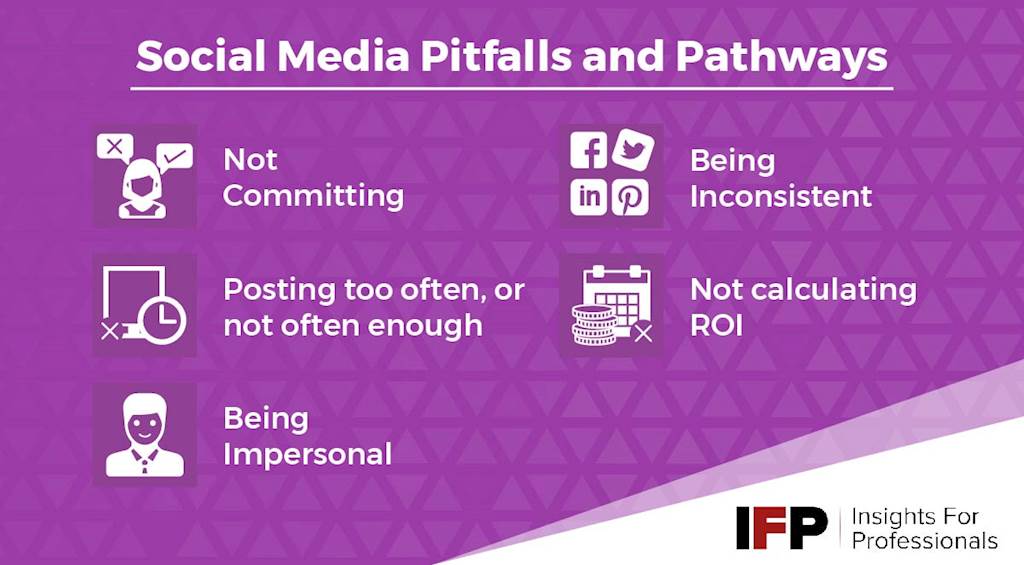Social media can be an amazing platform for expanding your business’ brand and generating new business, but it is also sometimes tricky to navigate.
Some of the most common, and damaging social media mistakes include:
- Not committing
- Posting too often or not often enough
- Being impersonal
- Being inconsistent
- Not calculating ROM & ROI
These, and ways to avoid them, will be discussed, so that you and your business can use social media in an effective and dynamic way.

Not Committing
With so many choices in terms of social media platforms, many companies fall into the trap of not sticking to the ones they choose. With new social media sites popping up at an exciting pace, it can be hard to decide which ones are worth investing time in.
Bear in mind that Facebook is still the largest social media site, with over 1.55 Billion active users, and it has been around for 12 years; so, while it is important to keep an eye open, it may be a waste of your time to constantly search for different options.
Solution
While specifics vary between businesses, it is generally better to stick to a few platforms best suited to your business, and post regular, good content, than constantly flip from platform to platform, leaving possibly valuable customers unable to keep up with your business.
In order to have a focused social media plan, you need to know which sites your customers are interested in, and you can do this by surveying them (by social media or email) and focusing your efforts on the platforms they use the most.
Posting too often, or not often enough
Once you have decided on which media platforms you will use, get your post balance right; post too often, people will grow annoyed and un-follow you; post too little and your presence on that site becomes pointless. Make sure to post regular, interesting content, limited to a few posts a day.
On a particular day, where you are advertising an event or something in particular, you can increase this amount, but avoid clogging up people’s feeds with too many posts at a time; you can use apps that time your posts to be released at regular intervals. You also might want to introduce a social media calendar to your business, so everyone in your team can be informed and up to date on what is being posted.
Solution
Discretion should guide you to post regular, interesting content, limited to a few posts a day. Not being attention greedy should get followers appreciating that you are not an aggressive firm, but are there to help.
Apps, such as Tweetdeck, are ideal for creating stable campaigns that spread content at regular intervals.
You also might want to introduce a social media calendar to your business, so everyone in your team can be informed and up to date on what is being posted.
It is your job to make sure the content is both interesting and relevant to your potential customers, some good ways of doing this include: reading forums, checking the social media mentions of your company and asking them (either through email or social media itself).
Being impersonal
This one is important, and it is where many businesses fall down when using social media.
It can be tempting to see social media platforms as simply free advertising for your business, however post after post relating only to your goods or services will seem impersonal, and cost you the respect and trust of potential customers.
Solution
Interacting with customers on social media will personalize your business and brand, people don’t want to feel they are communicating with a corporation - they want it to be personable. ‘Social media is viewed as the second-most effective digital marketing tactic for customer retention purposes, behind only email’, according to Business 2 Community and so it is important that your social media team are on hand to reply to any enquiries, queries and complaints that may pop up on social media.
Train your team in customer skills and the correct tone of voice for talking to people in person and on social media. Social media interactions take place in public rather than privately, on email or by phone, so handling them with immediacy and tact is important, and if you are able to do this, people will be convinced of the quality of your customer service – and business.
Being inconsistent
It is no secret that brand consistency is important, and this applies to social media as much as any other area. Many organizations fail to be consistent not just with their image but also with their post frequency.
Solution
Bryan Villanueva, multimedia director at Rand Group says that retaining brand consistency involves standardizing five key things: imagery, colors, core message, typography and audience. Make sure that these things are regulated across all platforms, and that your brand name and design are featured prominently.
When it comes to formatting text posts, have a similar set of rules to keep the tone consistent. Make a style guide detailing how content should be created and the specifics of all branding involved. Include things such as font, colors, icons and imagery, logo size and style, so that anyone who posts content can do so whilst complying with the brand.
Not calculating ROI
With so many variables, it can be difficult to measure your social media ROI (Return on Investment). Often, no accurate figure can be calculated, and instead you have to consider growth in other areas, such as traffic to your site and lead generation, both of which are expanding your brand.
Solution
A simple calculation for ROI in social media is ‘(SM return – SM investment) / SM investment %’. The good thing about social media is that it’s mostly free, so your investment should not be too high. However, it does take time, and as such needs to be assessed in terms of value.
Calculating ROI is also important in assessing any flaws in your social media strategy; you will be able to see which parts of your campaigns are working, and any areas that may need to be tweaked.
If you take these lessons on board, your business should be able to run a relatively smooth and successful social media campaign. It is important to bear in mind that since social media is a new frontier, it will be almost impossible not to make some mistakes, but keeping these tips in mind should ensure your business is strengthened because of it.
Access the latest business knowledge in Marketing
Get Access








Comments
Join the conversation...